Last week was a very emotional week, and I had to stay more away from the chain than expected. When real life decides to mess you up, it does it truly. Anyway, I hope this new week will be better…
Despite those troubling issues, collaborators and I managed to release a new research article last week. In this article, we propose a simple extension to the Standard Model of particle physics. So far there is of course nothing weird, as physicists propose and study new models on a daily basis. The specificity of our model is that it offers explanations for many of the anomalies currently featured in high-energy physics data.
In this model, leptoquarks strike back! Those non standard beasts, which I already introduced in this general blog three months ago and in this dark matter blog more recently, are again under the spotlight today. Leptoquarks are hypothetical particles appearing in many extensions of the Standard Model, and they have the key property to interact simultaneously with one quark and one lepton of the Standard Model.
In contrast to previous blogs, we discuss today a model containing three sets of leptoquarks. After all, we have three neutrinos, three charged leptons (electrons, muons and taus), three up-type quarks (up, charm and top) and three down-type quarks (down, strange and bottom) in the Standard Model. There is thus a natural motivation to design a leptoquark model with three species of leptoquarks.
In the research article considered, we investigate in which sense such a setup with three leptoquarks could help us to understand many of the potential hints for new phenomena available in data, and in particular those related to lepton flavour universality violation.
In the Standard Model, many properties do not change when we consider electrons instead of muons or taus, muons instead of electrons or taus, or taus instead of muons or electrons. For instance, the rate at which a Z boson decays into a pair of electrons is equal to that at which it decays into a pair of muons or into a pair of taus. This is what is called lepton flavour universality. Data seems however to contradict the Standard Model, and to exhibit several signs of violation of this universality.
As usual, those pushed for time can freely move to the summary of this blog provided at its end. For the others, be ready for an interesting particle physics story.
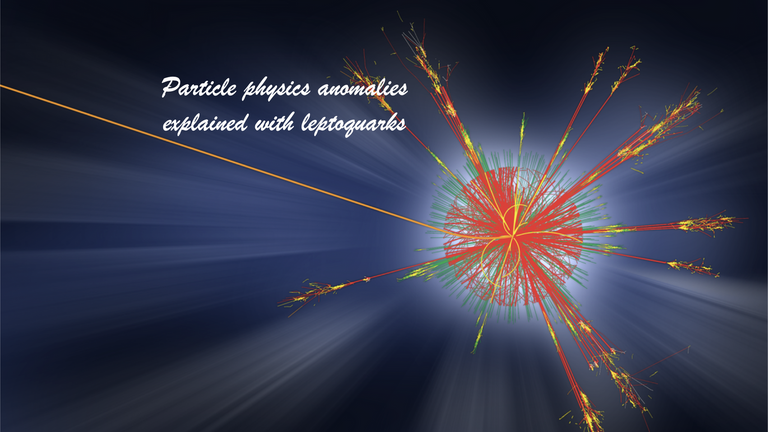
[Credits: Original image from CERN]
Leptoquarks in a nutshell
As already mentioned many times for those who follow me week after week, the Standard Model of particle physics is an amazing theoretical framework explaining all data acquired during the last century. All data? In fact, we should rather say almost all data. There are a few anomalies here and there. They are not big enough to lead to a claim for a new discovery, but they are significant enough to attract a lot of interest from physicists. In this context, finding an explanation to as many anomalies as possible is a funny exercice to tackle…
With my collaborators, we took many of those anomalies together and proposed a global explanation to them. Being global is very often what is complicated in this game. Whereas it is easy to explain one anomaly or a few of them with a single model, it is highly difficult to have a common explanation to a large number of anomalies.
In our work, we considered a dozen of anomalies, and managed to provide a simple explanation to all of them within a single particle physics model. This model features three species of leptoquarks.
Before discussing this in more details, let’s have a short discussion on what leptoquarks are. In the Standard Model, matter is made of quarks and leptons. We have six quarks (the up, down, charm, strange, top and bottom quarks) and six leptons (the electron, muon, tau, electron neutrino, muon neutrino and tau neutrino).
Quarks are the elementary particles making up all nuclear matter. They are in particular sensitive to the strong force (one of the three fundamental interactions). As a consequence, they can form composite systems like protons and neutrons, and these can be combined into all known atomic nuclei. For more information, I simply refer to this older blog on the topic.
In contrast leptons do not feel the strong interaction. They are only sensitive to electromagnetism and the weak force. The former allows in particular electrons to combine with atomic nuclei to form atoms.

[Credits: PXHere (public domain)]
In the Standard Model there is no single interaction involving simultaneously quarks and leptons. Quarks interact among themselves through the three fundamental forces of the Standard Model (and through the Higgs boson). Similarly, leptons interact among themselves, but this time only through two of the fundamental forces (and through the Higgs). As said above, leptons are indeed not sensitive to the strong force.
Leptoquarks are hypothetical particles that set up a connection between quarks and leptons. This is exactly why leptoquarks are called leptoquarks: we can find both the words lepton and quark in their name. Leptoquarks are hence not only sensitive to all three fundamental interactions of the Standard Model, but they also feature a new interaction with one single quark and one single lepton.
A new physics model with three species of leptoquarks
In the model proposed with my collaborators, we have been one step further. In the Standard Model, all particles are organised in three sets. Therefore, why can’t we include three copies of leptoquarks in a particle physics model?
In the Standard Model, the electron, the electron neutrino, the up quark and the down quark form the first generation of matter particles. Similarly, the muon, the muon neutrino, the charm quark and the strange quark form the second generation of matter particles, and the tau lepton, the tau neutrino, the top quark and the bottom quark consist of the third generation of matter particles.
In our model, we keep this organisational principle and introduced one leptoquark for each generation of Standard Model particles. We coined these leptoquarks the electroquark, muoquark and tauquark by analogy with the lepton names.
In other words, the electroquark interacts only with electrons, electron neutrinos, up quarks and down quarks. In addition, the muoquark interacts only with muons, muon neutrinos, charm quarks and strange quarks and the tauquark finally interacts only with taus, tau neutrinos, top quarks and bottom quarks.
It is now time to move on with the other big topic of this blog: lepton flavour universality and the related anomalies.
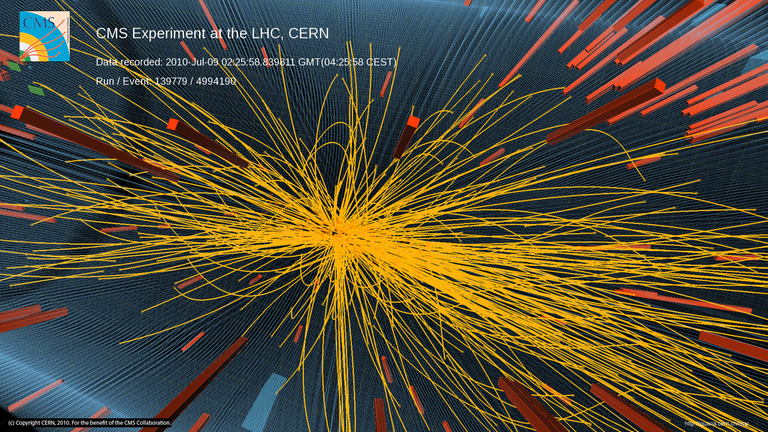
[Credits: CMS @ CERN]
Lepton flavour universality in the Standard Model
In the Standard Model, lepton flavour universality is automatically built in. Here the expression lepton flavour refers to the fact that physical observations should not depend on the type of leptons involved in a process. The origin of such a property is easy to see. The only difference between the three generations of leptons is their mass, that is small compared with the energy scale of many processes. Therefore, this difference can barely yield any effect. This would be like computing special relativity effects to the motion of a car: this is not needed, as these effects are negligible.
Let’s pick an example. I mentioned above Z boson decays.The Z boson is instable and can decay in many ways. It can decay into a pair of quark-antiquark (up, down, strange, charm and bottom). It can also decay into a pair of neutrino-antineutrino or a pair of charged lepton-antilepton. The latter gives one channel for an electron-positron final state, one channel for the muon-antimuon final state and one channel for the tau-antitau final state. The three corresponding decay rates are identical in the Standard Model.
The measurements agree with that, and we quantitatively find (see here) that a Z boson has 3.3632% of chances to decay into an electron-positron pair, 3.3663% of chances to decay into a muon-antimuon pair and 3.3658% of change to decay into a tau-antitau pair. Taking into account the uncertainties on those numbers, they can be considered as all the same!
The Standard Model includes many more examples in which the actual lepton flavour of the final state is irrelevant. Lepton flavour universality is an expectation from the Standard Model.
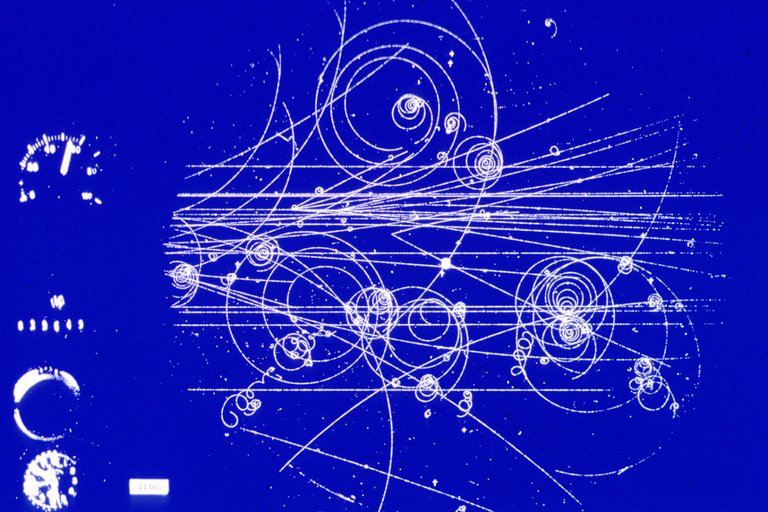
[Credits: CERN]
Lepton flavour universality violation
Whereas there is nothing wrong with the idea of lepton flavour universality, data starts to mess up with us.
One of the most intriguing pieces of evidence are related to B meson decays. B mesons are composite quark-antiquark systems comprising one bottom quark or antiquark (see here for more information about the formation of composite systems made of quarks and antiquarks). They can decay into a D meson, a charged lepton and a neutrino (where a D mesons are composite quark-antiquark systems comprising one charm quark or antiquark).
The Standard Model predicts that B meson decays into any lepton flavour are all similar, up to some sub-leading mass effects. Data shows however that B meson decays into D mesons exhibit very strong hints of lepton flavour universality violation. In other words, the measurements are far off relative to the expectation from the Standard Model.
Other very popular examples include the decays of B mesons into kaons and a lepton-antilepton pair. Here, a kaon is another system made of one quark and one antiquark, one of them being this time a strange quark. Here again, we expect lepton flavour universality. In particular, decays into kaons and an electron-positron pair should occur with the same rate as decays into kaons and a muon-antimuon pair. However… data exhibits measurements that are 15%-30% smaller! Lepton flavour universality seems again violated very strongly.
Browsing into all data available today, it quickly turns out that the list of anomalies related to lepton flavour universality violation gets long. Even when considering one of the simplest Standard Model processes at the Large Hadron Collider, namely the production of a pair of leptons from proton-proton collisions, potential issues show up. In addition, we cannot ignore longstanding hints for new phenomena associated with anomalous magnetic and electric moments of leptons.
All of those point to the same thing: lepton flavour universality violations.
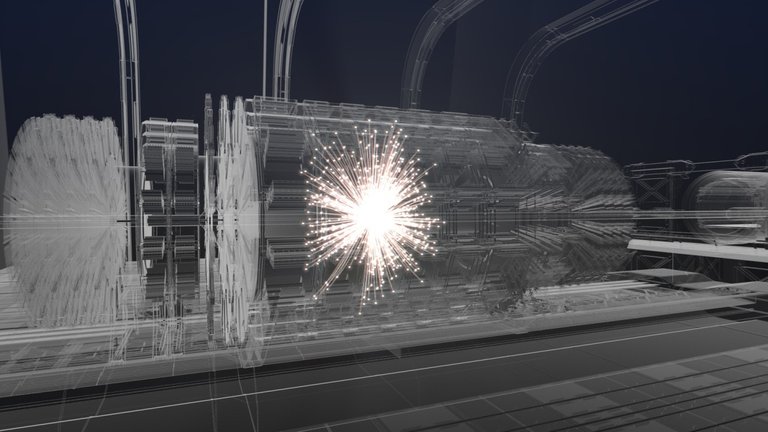
[Credits: CERN]
Three families of leptoquarks to save the day
The main goal of our research work was to propose a simple model of physics beyond the Standard Model that could explain all existing lepton flavour universality anomalies in one shot. Among all anomalies, those related to B meson decays are gaining the most traction at the moment, and leptoquarks are natural candidates to explain them. The reason is an easy one. On the one hand, leptoquarks interact simultaneously with quarks and leptons. On the other hand, these anomalies are related to decay processes in which a composite state made of quarks and antiquarks decays into leptons. The conclusion is immediate: leptoquarks can help.
Considering a particle physics model including a leptoquark then helps to restore agreement between theory and data. However, it has been found that a model featuring a single leptoquark cannot easily provide a common explanation to all flavour anomalies.
In our work, we constructed a model in which we assign one leptoquark with each generation of Standard Model particles. In other words, we equipped the theory with an electroquark (a leptoquark coupling to electrons, electron neutrinos, down and up quarks), a muoquark (a leptoquark coupling to muons, muon neutrinos, strange and charm quarks) and a tauquark (a leptoquark coupling to taus, tau neutrinos, bottom and top quarks).
As a result, we can tune differently the way the three leptoquarks interact, and hence provide an explanation to a large set of intriguing hints for lepton flavour universality violation. In addition, we demonstrated in our publication that it is possible to do so without violating any existing constraint on new phenomena. It is indeed great to explain signals, but it is even better to do so without destroying the rest…
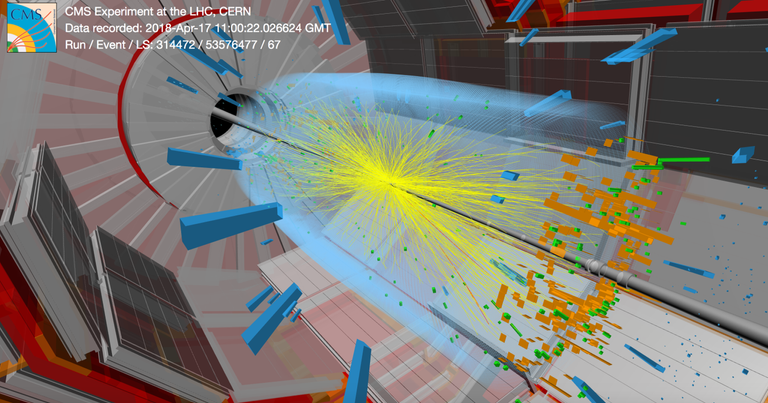
[Credits: CERN]
TLDR: restoring agreement between particle physics data and predictions thanks to leptoquarks
I discussed today one of my recent research works in which collaborators and I proposed a new model of particle physics including leptoquarks, hypothetical particles interacting simultaneously with one lepton and one quark of the Standard Model.
The Standard Model is organised in three generations of particles. We have a first generation containing electrons, electron neutrinos, up quarks and down quarks, a second generation including muons, muon neutrinos, strange quarks and charm quarks, and finally a third generation containing taus, tau neutrinos, bottom quarks and top quarks. In our model we kept this organisational structure and added to each generation a dedicated leptoquark. This choice is not a random one, as it consists of a great framework to explain many anomalies observed in data.
The Standard Model lives with lepton flavour universality. This means that any observables do not depend on whether we have electrons, muons or taus involved in a process. However, data seems to tell us this is not the case. This is especially true for processes in which mesons (composite particles made of one quark and one antiquark) containing a bottom quark decay into mesons containing either a strange quark or a charm quark, and leptons.
In our model with three leptoquarks, we demonstrated that we have enough flexibility to provide an explanation to all these signs of lepton flavour universality violation. Moreover, the model can do much more. It additionally helps us to understand unexpected features showing up in lepton pair production at the Large Hadron Collider, and to restore agreement between data and theory for lepton anomalous magnetic and electric moments.
In other words, the combined presence of several leptoquarks in the model allows us to explain a vast set of anomalies. The interesting point is that the explanation can feature light leptoquarks, so that there are hopes to see them soon at particle colliders (if existing of course). In parallel, we will stay very focused on the evolution of all anomalies in the coming years. Maybe at the end of the day, new phenomena are not very far from us…
I stop here for today, and wish all of you a wonderful week. As always, any form of engagement (questions, comments, suggestions, feedback) is appreciated! See you tomorrow or after-tomorrow for the next episode of my citizen science project on Hive (episode 1 is available here).

